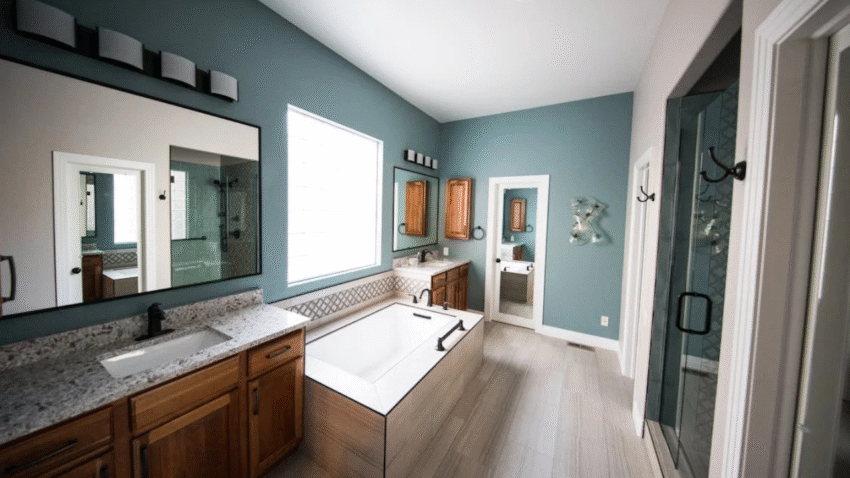Introduction
Are your bathroom tiles looking dull or stained no matter how often you clean them? This guide will show you how to scrub bathroom tiles without damage—restoring their shine without harming the surface. Many people use harsh tools or chemicals that scratch or strip the finish. Tired of scrubbing endlessly only to end up with worn tiles or discolored grout? Let’s fix that with the safest and most effective method.
Why Cleaning Bathroom Tiles Properly Matters
Bathroom tiles deal with constant moisture, soap scum, and grime buildup. Whether on your shower wall, floor, or backsplash, unclean tiles can develop mildew, slippery surfaces, and stained grout. But aggressive cleaning methods can wear down the finish, erode grout lines, or even crack ceramic. Proper scrubbing preserves the beauty of your tile, extends its lifespan, and prevents damage caused by moisture and mold. Clean tiles also improve air quality and make your entire bathroom feel fresh and polished.
Step-by-Step Guide to Scrubbing Bathroom Tiles Without Damage
1. Choose the Right Cleaning Solution
Skip the harsh chemicals—gentle solutions often work better and are safer for your tile finish. Here are some effective, tile-safe options:
- White vinegar + water (50/50 mix): Best for soap scum and light stains
- Baking soda paste (baking soda + water): Great for stubborn spots
- Hydrogen peroxide (on grout only): Kills mold and brightens lines
- Commercial pH-neutral tile cleaner: Designed to clean without damaging enamel or grout
Important: Avoid bleach or ammonia on natural stone tiles like marble or granite—they cause etching and discoloration.
2. Gather Your Tools
The right tools make all the difference. Here’s what you’ll need:
- Soft-bristle scrub brush or old toothbrush
- Microfiber cloth or sponge
- Spray bottle
- Bucket of warm water
- Grout brush (optional)
- Rubber gloves
- Old towel or kneeling pad
Avoid metal brushes or scouring pads—they can scratch ceramic, porcelain, or stone tile surfaces.
3. Pre-Rinse the Tiles
Start by rinsing your tile surface with warm water. This removes loose dirt and preps the area for deep cleaning.
In showers, simply run hot water for a minute. For floors or backsplashes, use a damp cloth or sponge.
Tip: Open a window or run an exhaust fan to reduce humidity buildup as you clean.
4. Apply Your Cleaning Solution
Spray your chosen cleaning solution generously across the tile surface. If you’re using baking soda paste, spread it evenly with a soft sponge or your fingers.
Let the solution sit for 5–10 minutes to break down soap scum and mineral deposits.
Pro tip: For vertical surfaces, apply the paste from bottom to top to avoid runoff streaks.
5. Scrub Gently in Small Sections
Use a soft-bristle brush or sponge to scrub tiles in circular motions. Focus on small sections—about 2 square feet at a time—for thorough cleaning.
- For ceramic or porcelain tiles: Use moderate pressure
- For natural stone: Use only microfiber or non-abrasive pads
- For textured tiles: Use a soft brush to reach into grooves
Pay attention to corners and grout lines, but avoid scrubbing too hard—this can loosen or chip grout.
6. Clean the Grout (If Needed)
If grout is stained or moldy, apply hydrogen peroxide or a baking soda–vinegar paste. Use a grout brush or old toothbrush to gently clean between tiles.
Rinse often so dirty water doesn’t settle back into the grooves.
Tip: Avoid acidic solutions like vinegar on unsealed grout—it can weaken the material over time.
7. Rinse Thoroughly
After scrubbing, rinse the area with clean warm water. Use a microfiber cloth or mop to wipe away any remaining residue. Make sure to remove all cleaner from the surface to avoid a slippery or sticky finish.
Don’t skip this step—leftover cleaning agents can attract more dirt and dull the shine.
8. Dry the Area Completely
Use a dry towel or microfiber cloth to wipe tiles dry. Drying helps prevent water spots and mold regrowth—especially in corners or along grout lines.
If cleaning the shower, leave the curtain or door open and turn on the exhaust fan to help air out moisture.
Common Mistakes to Avoid
Mistake 1: Using Abrasive Tools
Scrub pads or steel wool scratch most tile surfaces.
Solution: Always use soft brushes or microfiber cloths for safe cleaning.
Mistake 2: Skipping Rinse and Dry
Cleaning agents can leave a film that attracts dirt.
Solution: Always rinse thoroughly and dry with a clean towel.
Mistake 3: Using Harsh Chemicals on Natural Stone
Acidic cleaners damage stone tiles.
Solution: Use pH-neutral cleaners or stone-specific products.
Mistake 4: Scrubbing Grout Too Hard
Aggressive scrubbing can chip grout or expose gaps.
Solution: Use gentle pressure and soft tools like toothbrushes or nylon grout brushes.
Mistake 5: Cleaning Too Infrequently
Built-up grime requires more force to remove.
Solution: Spot-clean tiles weekly and deep-clean monthly to avoid heavy buildup.
Extra Tips & Bathroom Hacks
- Use a Daily Shower Spray: Prevent buildup by spraying tiles with vinegar-water after each shower.
- Squeegee Walls: Use a small squeegee to remove water from walls and tiles after every shower to reduce soap scum.
- Seal Grout Annually: This prevents moisture absorption and keeps grout looking clean longer.
Want to keep going? Check out our guide on how to clean moldy grout like a pro.
Conclusion
Scrubbing bathroom tiles doesn’t have to mean risking damage. With the right products, tools, and gentle techniques, you can lift away grime while preserving your tile’s shine and strength. The key is to clean consistently, use non-abrasive methods, and avoid moisture buildup after you’re done.
🧼 Bookmark this guide and give your bathroom tiles the care they deserve—without ever scratching or stripping them again.
